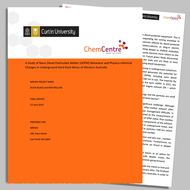Results outlined at free information session
| Date: | Monday, 29 July 2019 |
|---|
The results of two research projects into nano diesel particulate matter (nDPM) were outlined at a free information session hosted by the Department of Mines, Industry Regulation and Safety today.
In 2016, the Mining Industry Advisory Committee (MIAC) commissioned the research projects into the physical-chemical properties of nDPM in an underground mine and the potential health effects on workers from exposure.
DMIRS Director of Mines Safety Andrew Chaplyn, who is chair of MIAC, announced the completion of the two research projects on diesel emissions in the WA underground mining industry.
“Diesel engine exhaust (DEE) is a known hazard for mining operations, especially in underground mines where widespread use of diesel vehicles and equipment means control at source, and providing appropriate ventilation is critical to ensure worker health and safety,” he said.
“Now that the research has been finalised, MIAC will consider the findings and make recommendations to the Minister for Mines and Petroleum Bill Johnston.”
DMIRS and the Mineral Research Institute of Western Australia (MRIWA) co-funded the first research project which focussed on evaluating the physical-chemical aspects of DEE.
DMIRS also funded the second research project into the possible health impacts of DEE exposures. Twenty above-ground and 80 underground miners underwent a series of health screening tests and were fitted with personal exposure monitoring equipment to investigate whether their work exposures had an effect on their health status. The findings from this research is undergoing peer review prior to publication in academic journals.
Curtin University, the ChemCentre and the University of Western Australian conducted the research in collaboration with DMIRS and MRIWA.
“The research reinforces DMIRS guidelines on DEE, which highlight the importance of monitoring diesel emissions and implementing control measures to make the environment suitable for workers,” Mr Chaplyn said.
“This includes focusing on the fuel and combustion efficiency of on-site diesel engines, implementation and maintenance of effective engine filtration systems, adopting good ventilation design standards and regular employee training to promote the importance of minimising emissions and controlling worker exposures.
“DMIRS recommends mining operators consider technological advancements in monitoring nanoparticles and emerging epidemiological studies when developing their long-term management strategies.”
Applying the principles contained in the MIAC-endorsed guideline on Management of diesel emissions in Western Australian mining operations will assist mining operators to act proactively and promote a safe and healthy work environment.
DMIRS Mines Inspectors continue to conduct research aimed at evaluating underground working environments in order to minimise worker exposures to a range of potentially harmful agents, including DEE.
“Previously the Inspectorate focussed on evaluating DEE concentrations in underground mines in the Goldfields, and in 2018 a similar campaign was commenced, specifically targeting nanoparticles in underground mines in the Murchison district,” he said.
“The diesel particulate research reinforces the importance of managing DEE, and will assist mining operators develop emission exposure controls and long-term health management strategies.”
The findings of the research projects were outlined at a forum hosted by DMIRS today and a copy of the consolidated report on the physical-chemical aspects of DEE is available at http://www.dmp.wa.gov.au/Safety/Reports-16199.aspx. Also available is a literature review of recent research findings relevant to worker exposure to DEE, with a specific focus on newer engine and after-treatment technologies.
*Note: The Mining Industry Advisory Committee, advises and makes recommendations to the Minister and the Commission for Occupational Safety and Health on occupational safety and health matters concerning the mining industry.

